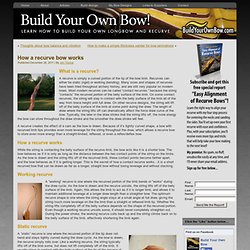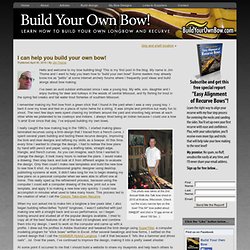

Www.vintageprojects.com/archery/recurve-bow-plans.pdf. How a recurve bow works. What is a recurve?

A recurve is simply a curved portion of the tip of the bow limb. Recurves can either be static (rigid) or working (bending). Many sizes and shapes of recurves have been tried throughout archery history, and are still very popular on modern bows. Most modern recurves can be called “contact recurves,” because the string “contacts” the recurved portion of the belly surface of the limb. On some contact recurves, the string will stay in contact with the belly surface of the limb all of the way from brace height until full draw. A recurve creates the effect of a cam as the bow is drawn. How a recurve works While the string is contacting the belly surface of the recurve limb, the bow acts like it is a shorter bow. Working recurve A “working” recurve is one where the recurved portion of the limb bends or “works” during the draw cycle.
Bow Making Tools. Build Your Own Bow. Splitting an osage log into bow staves. Build Your Own Bow author, Jim, poses with the staves. A straight Osage Orange log is like a log of gold to a selfbow bowyer. As you probably know, Osage trees don’t usually grow very straight, so finding a clean, straight one is a rare find. My friend Brent brought one over to my house this weekend for us to split into staves. It was about eight-to-10 inches in diameter at the base and almost perfectly straight! He cut it down on his farm in northern Boone County, Missouri, and he wants to make a bow out of it since it grew on his property.
This will be his first bow build, so I am encouraging him to make one by himself. The hedge tree was growing next to the road so he had to top it out first before dropping it so it wouldn’t completely block traffic in the road when it came down. We started by inspecting the ends for natural cracks, then splitting the log in half from end-to-end by leap-frogging the wedges down the length of the trunk. The first split opened up into separate halves. Finding time to make a longbow or recurve bow. Are you struggling to find time to build your own bow? Working all day every day, then coming home to do chores and family activities leaves you exhausted and completely out of time for working in your shop. You make plans to work in your shop on the weekend, but once all of the mowing, wood cutting, weed pulling, house cleaning, cooking, and laundry are done, its already Sunday night and the weekend is over.
You’ve dreamed about starting your bow making project, but just can’t find the time to get started. Or maybe you’ve already started working on your bow, but now you seem stuck and can’t find your way back into the shop to get it done. Sound familiar? Over the last few months I’ve made some MAJOR changes to the way I manage my time. 1. This may seem a bit off the subject of making bows at first, but stick with me and consider trying this, because I think it will help. Start with generalities first, maybe something like this: Lose 50 pounds. How to install buffalo horn overlays on limb tips. A footed take-down recurve and woodies for my friend Brent. My friend Brent is new to traditional archery and asked me to build him a take-down recurve. I built this one using my blueprints for a 21″ riser and “C” limbs. These combine to make a 64″ AMO bow. This one turned out at 70#@28″. The riser is the “footed” riser design. The reddish wood with black streaks is cocobolo and the brown wood with black streaks is shedua.
(Click on each photo below to see it larger.) The Force/Draw Curve. Knife scales for longbow tips? I’ve often admired all of the different types of exotic knife scales for sale at Ebay, and I’ve always thought that they would be the perfect size for use on longbow tips. So, I figured that I would get some and give them a try on my next longbow project. Recently, while I was shopping around Ebay to see if I could find any decent deals on bow materials or exotic wood blocks, I did a little search for knife scales and found a couple of sets that I think will work well.
I found this nice retro-looking pair of mint green, linen micarta scales and this nicely figured pair of water buffalo horn scales and put down some fair bids in hopes that I would win. If there was a “Buy It Now” price, I probably would have selected that option, because I can’t tell you how many auctions that I’ve lost and ended up without the materials I need. I can help you build your own bow! Hello and welcome to my bow building blog!

This is my first post in the blog. My name is Jim Thorne and I want to help you learn how to “build your own bow!” Some readers may already know me as “jwillis” at some internet archery forums where I frequently post ideas and build alongs about bow making. I’ve been an avid outdoor enthusiast since I was a young boy. My wife, son, daughter and I enjoy hunting for deer and turkeys in the woods of central Missouri, and fly fishing for trout in the spring fed creeks and tail water trout fisheries of southern Missouri.
Long Bows. American Flat Bows. Repeating Crossbow.